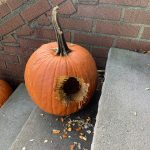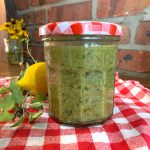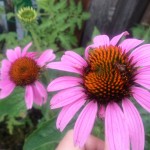The U.S. Department of Agriculture’s Natural Resources Conservation Service has said “Mulching is one of the simplest and most beneficial practices you can use in the garden.” Knowing this, why did I skip mulching this spring? I’m regretting it now. The weeds are a constant in any garden but without mulch, it becomes unmanageable. Every few days it seems the weeds reappear. A 2-3 inch layer of mulch will prevent seeds from planting in the soil. For the relentless roots of weeds, (ahem, morning glories) mulch blocks out sunlight which halts growth.
Another benefit to mulch – water retention. Mulching retains about 80% of the water in your soil. It prevents evaporation, and runoff and stabilizes ground temperature in the heat of the summer and the cold of the winter. With this, gardens that are mulched produce more fruits/vegetables and ornamentals grow bigger and healthier.
I came across an interesting article in the NY Times – Why Your Garden Needs Mulch (Assuming You Do It Right). It discusses the concept of “passive composting.” Unlike composting as we know (adding greens, browns, turning, etc.), using mulch mirrors the natural process of soil enrichment on forest floors. And it’s easier. Passive composting happens when saprophytes organisms such as fungi, bacteria, protozoa, nematodes, and earthworms digest and break down mulch.
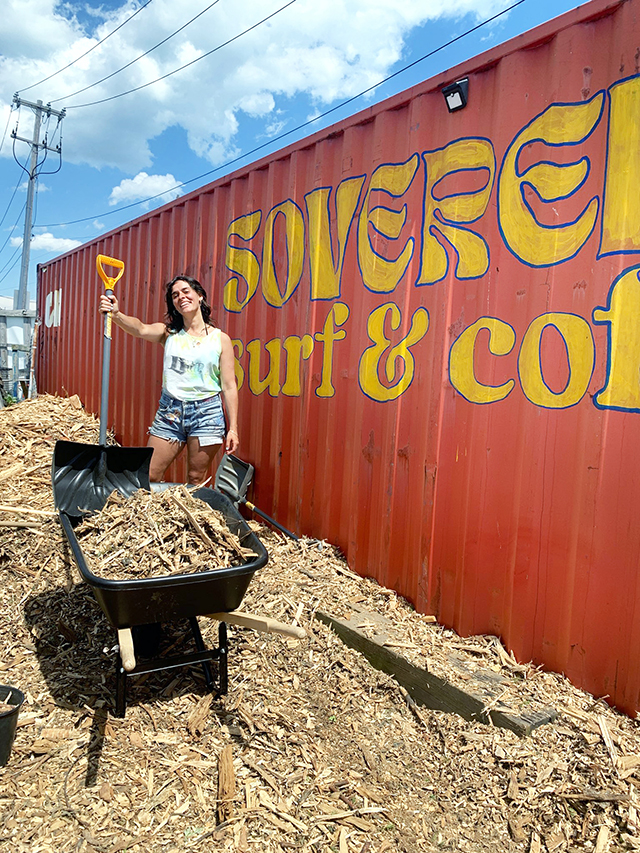 Teresa Farrell understands the benefits of mulching.
Teresa Farrell understands the benefits of mulching.
What exactly is mulch? We mostly associate mulch with wood chips. In actuality, it is defined as – covering your soil with a protective layer. Mulch can be brown paper bags, newspapers, twigs, bark, leaves, straw, and tall grasses.
The article points out that most of us (and our landscaping services) mulch the wrong way – for aesthetic purposes. Hey, I get that but we can find a balance. Try collecting garden debris throughout the year for the most natural form of mulch. Come fall, leave expended organic material under your trees/shrubs throughout the winter. If possible, keep this material as your mulch in the spring. If you do remove it for aesthetics, wait until the middle of May. Not only will it grow soil, but this natural layer is also home to many important insects that benefit your garden.
Learning about the rewarding benefits of mulch is a step in understanding your garden and its natural functions. Mimicking the inherent process, think “forest floor” is best for your garden and the ecosystem it supports. Remember, your garden is an interconnected natural organism that knows what it needs to do. Your job is simply to finesse it along.
If you don’t have homegrown mulch at this point in the season, visit our local garden center for bagged mulch. (Lisena Garden Center, 12-5 Cross Bay Blvd,). If you need to cover ground, contact tree pruning services. They will most times give and deliver mulch material for free as it costs them money to dispose of it. In fact, Sovereign Surf & Coffee (111-30 Beach Channel Dr.) did just that a few weeks ago. Terence McNicholas, co-owner of the bayside surf cafe, had a 25 cubic yard truck load delivered to use at the outdoor cafe for weed prevention. And it looks fantastic! He had a mound leftover so on Instagram (@sovereign_surf), Terence announced a community mulch giveaway. My friend Teresa reached out. It was perfect timing. I’m helping her build a brand new garden at her home and the mulch from Sovereign Surf was hugely helpful.
However you get your hands on mulch, it’s not too late to lay it down this season. Your garden will thank you with abundance and beauty.
For the day-to-day follow Me in Rockaway on Instagram – @theglorifiedtomato.
Every summer I end up snacking on my serviceberry trees while I’m doing garden work. This year, I wanted to use the fruit in a proper way. I got out the ladder and harvested as many as I could. I left the berries on the very high branches. Partly for the birds and partly out of laziness. I gathered 9 cups! And there are still more on my tree in the front garden.
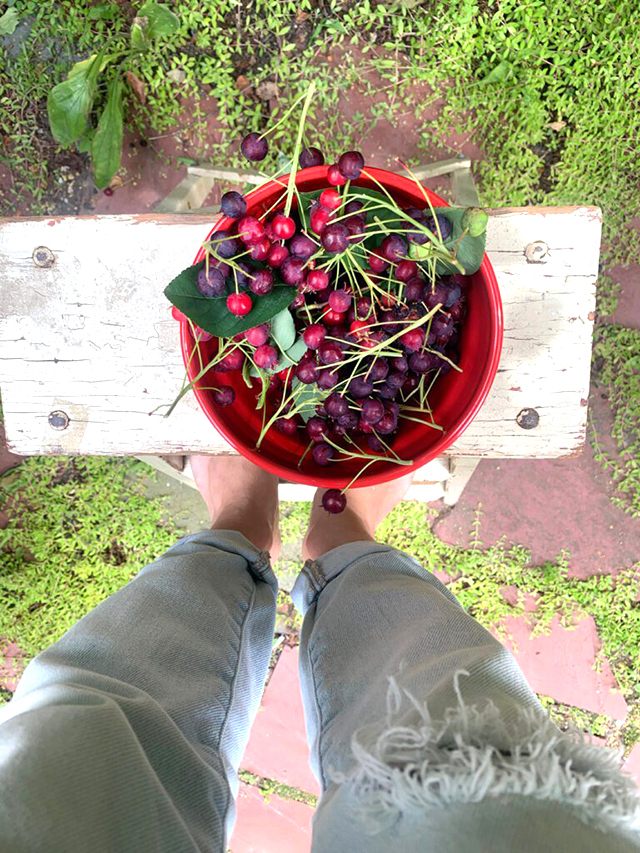
Use a scissor to clip the berry clusters
I decided to make juice. I muddled the berries and added water, ice, lemon, and mint from the garden. I gave the jar a good shake and let it sit in the fridge for a few hours.The taste of the serviceberry is similar to blueberries but sourer. It’s nice to harvest a variety – very ripe dark purple ones and the brighter reds. This combination gives both a rich, sweet flavor and a bold tartness.
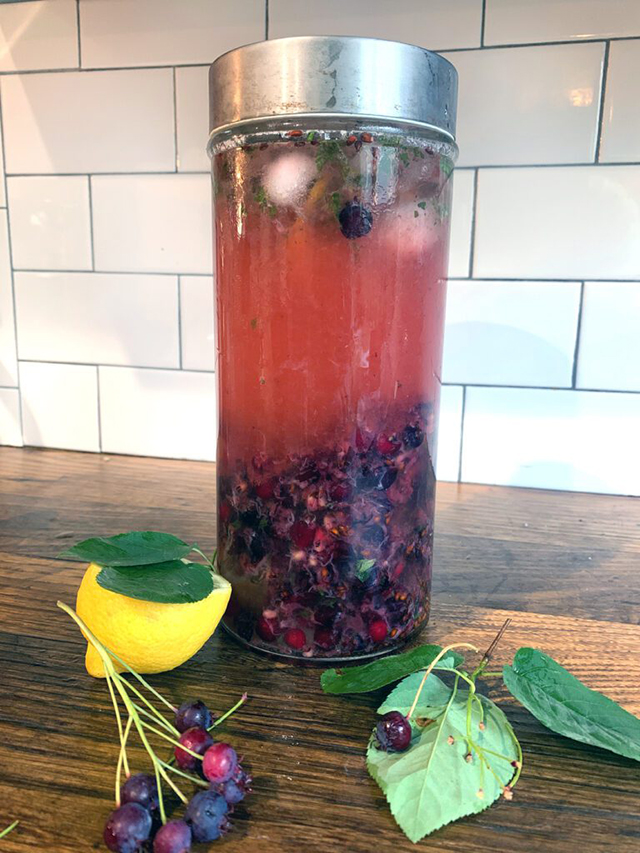
The drink is so refreshing, perfect for a hot summer day. The lemon and mint complemented each other very well. I may try adding ginger next time. Feel free to experiment, that’s the fun part. Here’s my recipe:
Serviceberry Cooler With Lemon And Mint
Ingredients:
1 cup serviceberries
1 lemon squeezed, plus a few slices for ornamental appeal
¼ cup mint leaves
(1 tablespoon sugar, optional)
3 cups water
1-2 cups ice
Directions: Remove the stems and rinse the berries. Muddle the berries and mint. Fill a pitcher or jar with water and ice. Combine the berries, mint, juice of one lemon, and lemon slices into the pitcher. Let the mixture sit in the refrigerator for at least one hour before serving.
Alternatively, for a thicker consistency, combine all the above ingredients in a blender. Store refrigerated for 1 week.
I still had berries left over so I used some in banana bread. I gave one to my friend Anna and another loaf to my friend Juan. It got rave reviews – both said it was delicious!
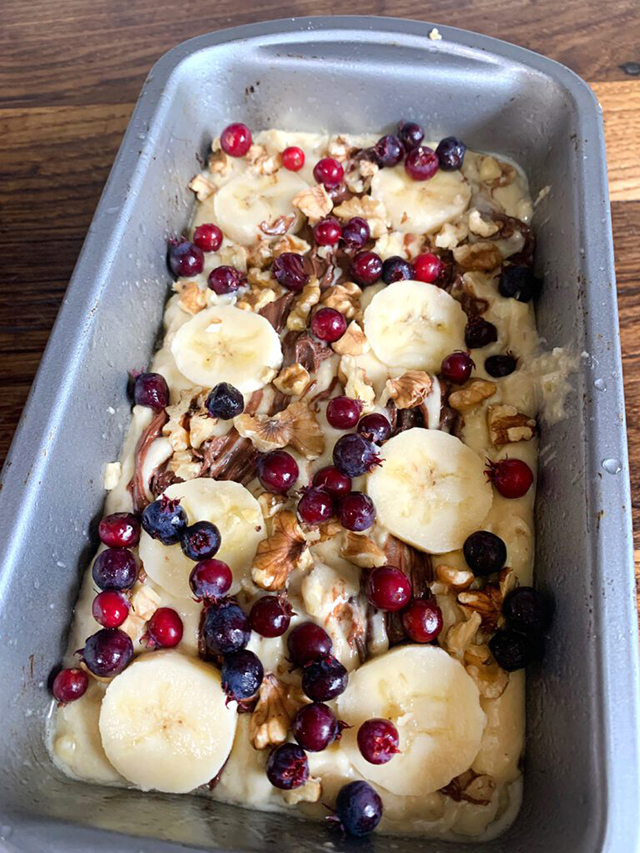
Serviceberries work great in baked breads or pies
I also froze a cup of serviceberries for use as ice cubes. You can do this with any small or chopped fruit. I add the berries to seltzer and create my own sparkling flavored drink. Who needs La Croix…
The serviceberry tree, also called a Juneberry, for its early June fruit, is native to North America. It’s in my top five favorite tree list (Yes, I have one). Why is this tree amazing? Because it displays all season long beginning in the spring with beautiful white flowers. Then it bears delicious berries in June. And in its final performance of splendor, the leaves turn shades of golden yellow in October. Keep your eyes open for this tree in Rockaway and forage it! They do well in sandy, light soil and it tolerates salt and drought. Gardeners in the know, plant them here on the peninsula for all their beauty, bounty, and easy care.
Follow me for the day-to-day on IG – @theglorifiedtomato.
My sister was out of town and I was watching her children. I wanted to make the most of my time and while the kids were in school, I took my friend Fernanda, who is visiting from Colombia, to the most important historical landmark on Long Island – The Big Duck.
The beautiful structure came into view as we were driving on the narrow country road. I was a little worried The Big Duck wouldn’t be open. The architectural marvel is also a quirky museum and gift shop. We hurried to the door. It was open and we excitedly entered!

Fernanda and I were greeted by Suffolk County Park Ranger Mr. T., a charismatic duck enthusiast and an encyclopedia on Big Duck’s fascinating history.
I was overwhelmed by the articles and photos that lined the walls. My eye immediately was drawn to the illustration of The Big Duck on the cover of The New Yorker, dated May 11, 1987. Mr. T. wasted no time and began speaking to us about Big Duck’s rich history.
Fernanda and I learned the structure dates back to 1931. At this time, there were Pekin duck farms everywhere in Suffolk County. It is said the ducks came via ship from China in 1870 and since this animal couldn’t fly, and its meat was delicious, the farming of Pekin developed quickly into a lucrative business. But competition was fierce. And so a savvy Riverhead duck farmer, Martin Maurer, and his wife Jeule had an idea to set their duck ranch apart from the competitors. The concept came about in California when the couple was on vacation. There, they passed by a roadside coffee shop that was shaped like a coffee pot. Here The Big Duck was conceived.

In 1988, a mysterious egg was found in the basement of The Big Duck
Maurer hired local carpenter George Reeves and two set designers, brothers William and Samuel Collins to erect the duck. A live duck served as a model. And the architects studied a carcass of a cooked chicken to create a plan for the frame. The duck is built of wood, wire, and mesh. The eyes are notably made from two Model-T tail lights. To this day, they glow red at night. The Big Duck is 30 feet from its beak to its tail. The beloved fowl stands a proud 20 feet high.
With the success of his business, Maurer purchased land and moved his ranch and the gigantic duck from West Main Street to its current location on Route 24 in Flanders, Long Island in 1936.
Duck farming declined in the 1960s when it became clear that the pollutants from this production were adversely affecting Suffolk county’s ecosystem.
In 1987, the big duck’s fate was threatened as the land it grazed was set for development. The community was outraged and organized to save the duck. They contacted local newspapers, created t-shirts, and even got the attention of Christie Brinkley, who advocated on public access television to save the duck. The efforts were a success and in 1987, instead of demolition, The Big Duck was delicately transferred to a nearby county park. At this time The Big Duck was generously gifted by the owners, the Eshgis to Suffolk County.

Myself and Mr. T
I found this amazing … yet again, in 2007, The Duck migrated. The development plans fell through and The Big Duck was moved back to its former site in Flanders, to the delight of the community. In 2008, Big Duck earned its rightful designation and was placed on the National Register of Historic Places.
The Big Duck is so iconic that a school of architecture was named after it. Duck Architecture is the official term for highly sculptural forms that represent products or services available within. Architect Robert Venturi and Denise Scott Brown introduced the terminology in 1968.
There’s so much more I’d like to share about the eccentric side of The Big Duck, like its mysterious egg, the country song, and my obsessive thoughts on the vintage “Save The Big Duck” t-shirt but that will have to wait for part two.
Visit The Big Duck when you find yourself unexpectedly out of Rockaway this summer – 1012 Flanders Rd., Flanders NY. And follow The Big Duck is on Instagram too!! – @thebigduckli.
I was watering my hanging baskets when I noticed hundreds of aphids on the underside of the delicate petunia petals. I almost fell off the ladder! Unmanaged infestations will kill plants within a few weeks. Aphids are very small bugs – bright green, burnt orange, or black in color. If you see them, take action quickly.
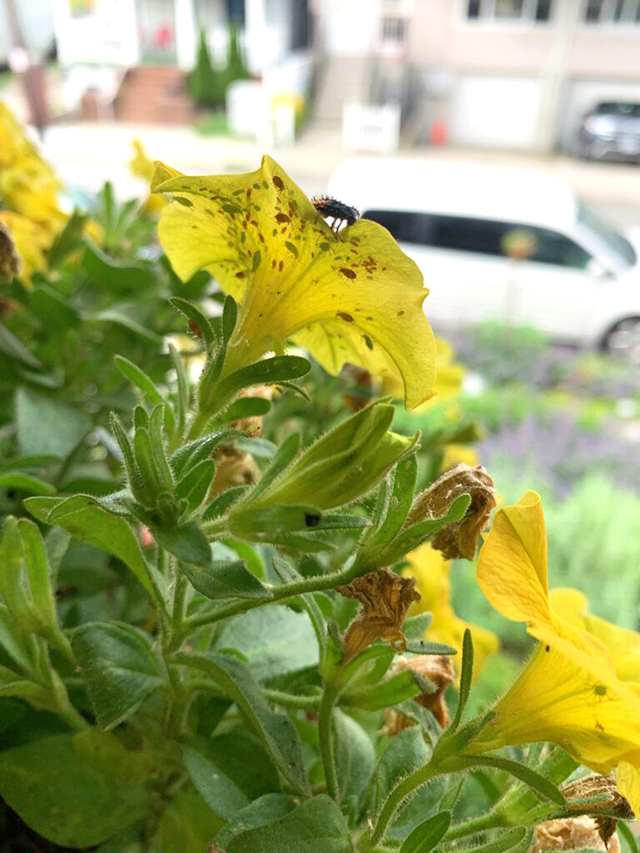
Here you can see aphids on the flower and one ladybug larva enjoying a feast.
To combat these garden pests, fill a water bottle and add natural dish soap (1-2 tablespoons). Shake, then spray the plants once a day until the aphids are gone. This is a simple, inexpensive home remedy.
Ladybugs love to eat aphids, thrips, and other similar garden pests. Immediately after hatching, the larvae begin to feast, consuming about 350 to 400 aphids in two weeks’ time. I’ve seen some ladybugs and larvae in my garden already but not enough to handle this emergency, so I opted for the soap solution.
Try the ladybug method as a preventive measure in the spring. You can order them online! This is a natural form of pest control, a great educational example for the children and ladybugs are really cute too.
A week after my aphid situation, the conversion of pest organic remedies came up at the Beach 91st Street Community Garden’s monthly meeting. Members David Rood-Ojalvo, Alice Buttrick, and Jules Verdone spoke about their pest problem with collard greens and kale last season. Look out for aphids, cabbage worms (small smooth, greenish caterpillars), and the harlequin bug (orange, yellow and white markings).
After research and experimentation from last season’s woes, the garden members determined an organic, spicy spray was an effective treatment for pests on collards. Combine chopped onion, garlic, cayenne pepper, and water in a spray bottle to protect your kale and collards. You may also add one tablespoon of plant-based soap. Spray on infected areas. Keep out of the reach of children and away from your eyes. Store in the refrigerator.
For a few years now the community garden has had a problem with the relentless squash beetle. Member Susan Graham sent helpful information to me about this pest.
The squash beetle’s eggs can be found on the underside of leaves. They’re dark, shiny, and appear in a row fashion in clusters of 10-20. Adults are fast-moving, brownish/black in color, and have flat backs. Adults and nymphs damage or kill the plant by sucking out vital liquid. The best remedy is to smush the eggs. If you see the beetles, hand pick them off and dispose of in soapy water. This is important… do not place damaged leaves or the plant in your compost pile. These pests overwinter and will return year after year. Place damaged or dead plant parts in a garbage bag.
The best defense for any garden pest is prevention. Sowing your own seeds and inspecting nursery plants is the first step. Early detection and management come next, followed by proper disposal of affected plants in the garbage. Always try to use natural, organic remedies, especially on vegetables! If I encounter other pests as the garden season continues, I will write about it or share information on my Instagram feed – @theglorifiedtomato. Good luck in the garden this season!
 Teresa Farrell understands the benefits of mulching.
Teresa Farrell understands the benefits of mulching.























